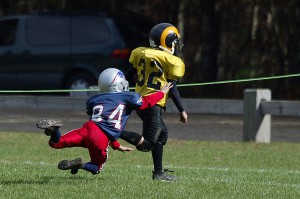This is the story of Peter and Damon, best friends and team mates. The guys were excited to be starting players for their junior varsity football team. They had practiced a lot during the summer and were gearing up for their first game. As they got ready for the final practice before the big game, Peter noticed that Damon was wearing something a little extra – a pair of goggles under his helmet. Damon said his uncle had recommended the goggles in case he was injured. Peter shrugged, commenting that he felt his helmet was protection enough because the coach never mentioned goggles.
The boys practiced hard that day. The conditions weren’t the best – an earlier rain left the turf a little damp and slippery. Toward the end of the session Peter’s foot slid and he fell toward a team mate. Unfortunately, Peter was poked in the eye, resulting in a corneal abrasion. While there was no permanent damage, the injury took several days to heal and Peter had to sit out the big game.
a little damp and slippery. Toward the end of the session Peter’s foot slid and he fell toward a team mate. Unfortunately, Peter was poked in the eye, resulting in a corneal abrasion. While there was no permanent damage, the injury took several days to heal and Peter had to sit out the big game.
Every year more than 25,000 people seek medical treatment for eye injuries which occur while playing sports. Approximately 78% of those injured stated they were not wearing eyewear at the time they sustained the injury. Of those who believed they were protected, only 5.3% were actually wearing safety or sports glasses.
Peter was lucky to have sustained a minor injury. He could have sustained a more serious sports-related eye injury such as an orbital fracture or a detached retina, both of which are potentially blinding.
The National Eye Institute reports that the greatest number of sports-related eye injuries occur in baseball, which is considered a high-risk activity along with basketball, boxing, hockey, paintball, and racquetball. Football, soccer, golf, and tennis are listed as medium-risk.
Ninety percent of sports-related eye injuries can be prevented by wearing protective eyewear. Here are some tips to remember:
- Eyewear and face shields should be made of polycarbonate, meet the requirements of the ASTM (American Society of Testing Materials), and be labeled “ASTM F803” approved.
- Sunglasses and prescription glasses/sunglasses do not provide adequate protection.
- Protective eyewear can be fitted with prescription lenses.
- Protective eyewear should be replaced when damaged or yellowed from age.
- The lenses of protective eyewear should pop outward when struck to prevent damage to the eye.
- Purchase eye protection that has an anti-fog coating or venting.
- Always try eye protection on before purchasing to make sure that it is the proper fit.
- For use under a helmet, choose goggles rather than eyeglass style.
After his eye had healed, Peter’s father helped him select sports goggles. Several of the boys on the team who wore glasses or contacts visited their eye care professionals to obtain goggles with prescription lenses.
Its too early to tell if the team will have a winning season, but they are scoring big when it comes to protecting their eyes.
